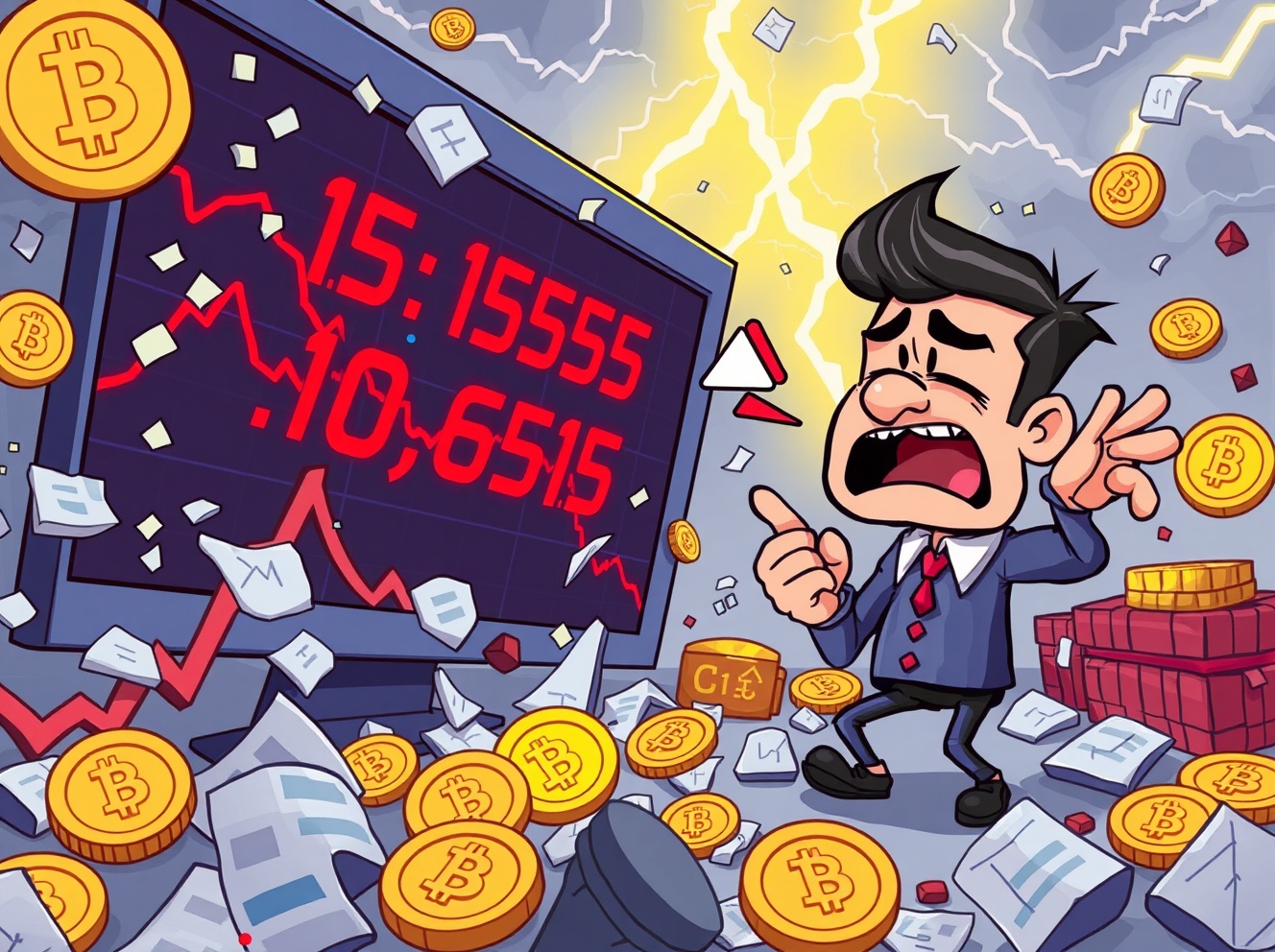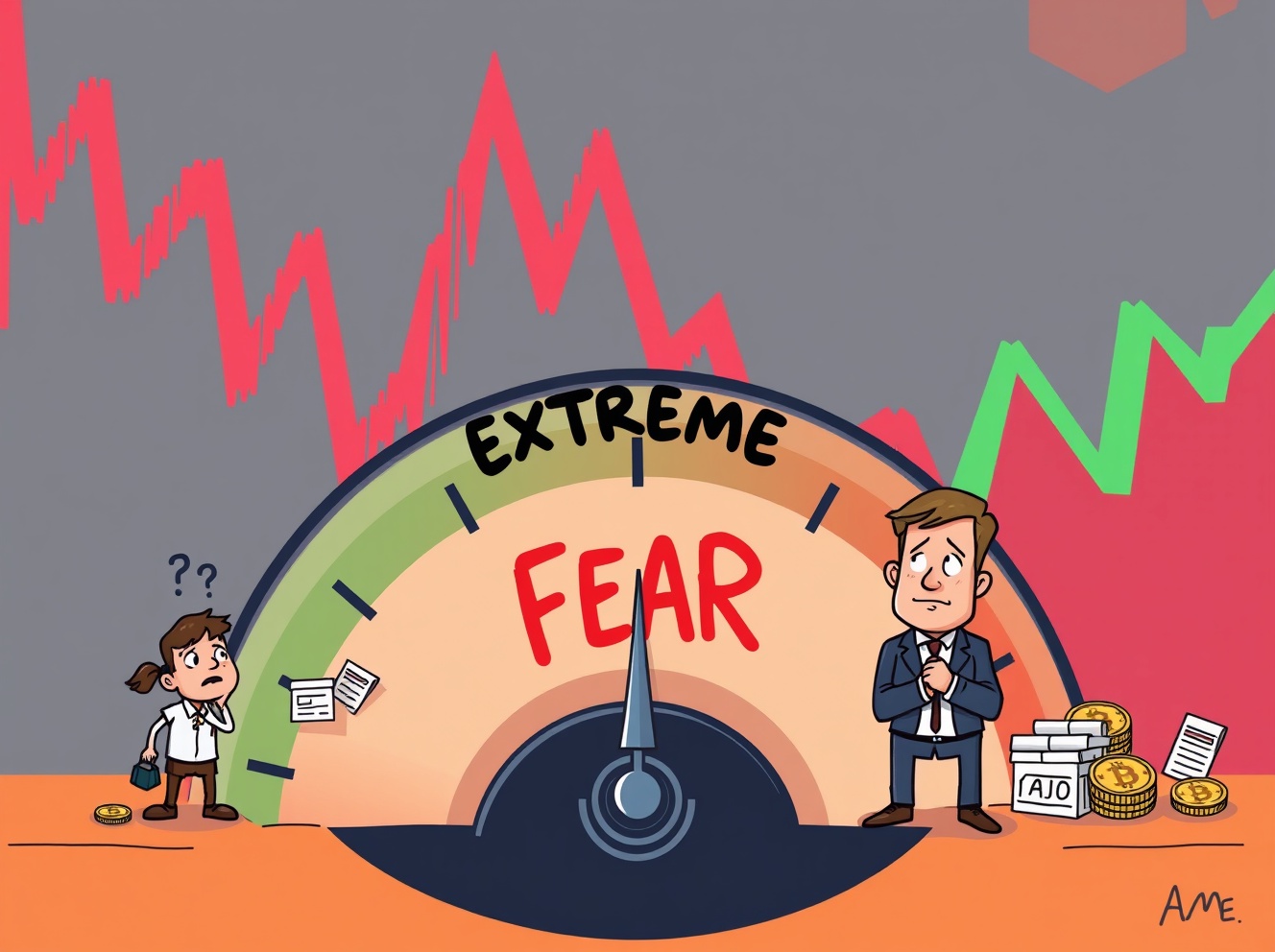
BitcoinWorld Crypto Futures Liquidation: Massive $470 Million Wipeout Shakes Markets The crypto market just witnessed a dramatic event: a staggering $470 million worth of crypto futures liquidation occurred in a single hour. This sudden wipeout is part of an even larger trend, with over $1.75 billion in futures positions liquidated across major exchanges in the past 24 hours. For many traders, this represents a significant financial blow and a stark reminder of the inherent volatility in the digital asset space. What does this mean for your trading strategy? What Exactly is a Crypto Futures Liquidation? When we talk about crypto futures liquidation , it might sound like complex financial jargon, but let’s break it down simply. Futures contracts allow traders to bet on the future price of an asset without owning the asset itself. Many traders use leverage, borrowing funds to amplify their potential gains. However, leverage also magnifies losses. If the market moves against a leveraged position, and the trader’s margin (the collateral they put up) falls below a certain level, the exchange automatically closes their position to prevent further losses. This forced closure is what we call a liquidation. It’s a crucial mechanism to protect both traders and exchanges from excessive debt. Futures Contracts: Agreements to buy or sell an asset at a predetermined price on a future date. Leverage: Using borrowed capital to increase potential returns. Margin: The collateral required to open and maintain a leveraged position. Liquidation: The automatic closure of a leveraged position by an exchange when a trader’s margin can no longer cover potential losses. Why Do Massive Crypto Futures Liquidations Occur So Suddenly? The recent surge in crypto futures liquidation events, like the $470 million hourly figure, often stems from rapid price movements. Cryptocurrencies are known for their extreme volatility. A sudden drop or pump in price can trigger a chain reaction. For instance, if Bitcoin’s price sharply declines, it can push many leveraged long positions (bets that the price will go up) into liquidation. As these positions are closed, it can add selling pressure, further driving down prices and triggering more liquidations in a cascading effect. This is particularly true during periods of high market uncertainty or significant news. Several factors contribute to these sudden, large-scale liquidations: Market Volatility: Unpredictable and swift price swings. High Leverage: Many traders use substantial leverage, making their positions highly sensitive to price changes. Cascading Effects: One liquidation can trigger others, creating a domino effect. Stop-Loss Hunting: Large market players can sometimes manipulate prices to trigger clusters of stop-loss orders and liquidations. Navigating Volatile Waters: How Can Traders Protect Against Crypto Futures Liquidation? Given the inherent risks, how can traders better protect themselves from sudden crypto futures liquidation ? Effective risk management is paramount. Understanding your exposure and setting clear boundaries can make a significant difference. Here are some actionable insights: Manage Leverage Wisely: Avoid excessive leverage. While it can amplify gains, it dramatically increases liquidation risk. Use Stop-Loss Orders: These automatically close your position if the price hits a predetermined level, limiting potential losses. Monitor Market Conditions: Stay informed about market news, sentiment, and technical indicators. Diversify: Don’t put all your capital into a single leveraged position. Maintain Sufficient Margin: Ensure you have enough collateral to withstand minor price fluctuations without being liquidated. By adopting these strategies, traders can significantly reduce their vulnerability to the unpredictable nature of the crypto market and the threat of a swift crypto futures liquidation . The Broader Impact of Recent Crypto Futures Liquidation Events Beyond the individual trader, massive crypto futures liquidation events have broader implications for the entire crypto ecosystem. Such significant liquidations can signal a period of heightened fear or uncertainty in the market. They can also temporarily depress prices as forced selling occurs, affecting spot markets as well. While these events are a normal, albeit dramatic, part of leveraged trading, their scale underscores the need for caution and robust risk management practices across the board. The $470 million liquidation in one hour and the $1.75 billion over 24 hours are not just numbers; they represent substantial capital shifts and market sentiment. These figures serve as a powerful reminder for both novice and experienced traders to approach leveraged trading with extreme care and a deep understanding of the potential pitfalls. The market is constantly evolving, and being prepared for such rapid shifts is crucial for long-term success. In conclusion, the recent $470 million crypto futures liquidation within an hour, alongside a massive $1.75 billion over 24 hours, highlights the dynamic and often brutal nature of leveraged cryptocurrency trading. While futures offer opportunities for significant gains, they come with substantial risks, primarily the threat of liquidation. Understanding what triggers these events and implementing robust risk management strategies are not just recommendations; they are necessities for anyone participating in this high-stakes environment. Stay informed, trade responsibly, and prioritize capital preservation. Frequently Asked Questions (FAQs) What is crypto futures liquidation? Crypto futures liquidation is the forced closure of a trader’s leveraged position by an exchange when their margin collateral can no longer cover potential losses due to adverse price movements. Why did $470 million in crypto futures get liquidated in one hour? Such a large liquidation typically occurs due to rapid and significant price movements in the underlying cryptocurrency, triggering stop-loss orders and margin calls across numerous highly leveraged positions simultaneously. How can I avoid crypto futures liquidation? You can reduce the risk of liquidation by using less leverage, setting effective stop-loss orders, maintaining sufficient margin, and continuously monitoring market conditions. Does crypto futures liquidation affect the spot market? Yes, large-scale liquidations can indirectly affect the spot market by increasing selling pressure, which can lead to temporary price declines as positions are forcefully closed. Is futures trading safe in crypto? Futures trading in crypto carries significant risk, especially with high leverage, due to market volatility. It is not inherently “safe” and requires extensive knowledge, experience, and strict risk management. Was this article helpful in understanding the recent crypto futures liquidation events? Share your thoughts and insights with your network! Help others navigate the complexities of crypto trading by sharing this article on your social media platforms. To learn more about the latest crypto market trends, explore our article on key developments shaping cryptocurrency price action. This post Crypto Futures Liquidation: Massive $470 Million Wipeout Shakes Markets first appeared on BitcoinWorld .
Bitcoin World
You can visit the page to read the article.
Source: Bitcoin World
Disclaimer: The opinion expressed here is not investment advice – it is provided for informational purposes only. It does not necessarily reflect the opinion of BitMaden. Every investment and all trading involves risk, so you should always perform your own research prior to making decisions. We do not recommend investing money you cannot afford to lose.
Big Bull Arthur Hayes Predicts How High Bitcoin Prices Could Go – “If US Politicians Want to Get Re-elected…”

Arthur Hayes, one of the well-known names in the cryptocurrency market, predicted that the Bitcoin price will reach $1 million by 2028. Hayes, co-founder of BitMEX, shared this prediction during his speech at the SALT Conference in London. “Bitcoin will be over $1 million and Ethereum will be $20,000,” Hayes said, adding that he expects a major peak in the crypto market before the next US presidential election in 2028. Hayes` comments came just hours after Bitcoin`s price fell below $100,000 for the first time since May. Bitcoin is currently trading around $103,000, 19% below its all-time high of $126,000 set in October, while Ethereum is trading at $3,340, 32% below its August all-time high. Related News: Ethereum (ETH) Plummets: Vitalik Buterin`s Wealth Evaporates - Here Are the Losses According to Hayes` analysis, Bitcoin`s rise stems from governments choosing to borrow rather than cut spending. A policy of austerity, meaning raising taxes, is unpopular with voters, so governments are choosing to continue borrowing for the sake of reelection. More debt means an increase in the fiat money supply. In Hayes` words, central banks are “pushing the money button.” Hayes argues that this will result in increased inflation, regardless of official statistics, and that Bitcoin will emerge as a hedge against inflation during this period. “People instinctively understand what’s going on,” Hayes said, “it’s just that everyone is trying to solve the same problem in different ways.” The country`s national debt currently stands at $38 trillion, the highest since the pandemic, according to data from the U.S. Treasury Department. According to Hayes, the likelihood of politicians abandoning the debt is extremely low. “This problem can be solved, but only if you don`t want to be elected,” Hayes said, adding that if governments stop borrowing and raise taxes, we could experience deflation on a scale not seen since the 1930s. *This is not investment advice. Continue Reading: Big Bull Arthur Hayes Predicts How High Bitcoin Prices Could Go – “If US Politicians Want to Get Re-elected…” Bitcoin World

Massive Crypto Futures Liquidation: Unpacking the Market Shock
BitcoinWorld Massive Crypto Futures Liquidation: Unpacking the Market Shock The cryptocurrency market just experienced a seismic event, with a staggering crypto futures liquidation totaling $285 million in a single hour. This immediate shockwave follows an even larger tremor: a colossal $2.01 billion worth of futures contracts liquidated over the past 24 hours. These numbers are not just statistics; they represent significant market volatility and impact countless traders. If you are involved in crypto, understanding these events is crucial. What is Crypto Futures Liquidation and Why Does It Happen? At its core, crypto futures liquidation occurs when a trader’s leveraged position is forcibly closed by an exchange. This happens because the trader’s margin balance falls below the required maintenance margin. Think of it like a safety net disappearing. Futures contracts allow traders to speculate on the future price of an asset without owning it directly. They often use leverage, which means they borrow funds to amplify their potential gains. However, leverage also magnifies losses. When the market moves sharply against a leveraged position, the trader faces a margin call. If they cannot add more funds to meet the margin requirements, the exchange automatically liquidates their position to prevent further losses for both the trader and the exchange. Such massive liquidation events, like the recent $285 million in an hour, are often triggered by sudden price swings. These swings can be caused by macroeconomic news, regulatory announcements, or even large institutional trades. Consequently, a cascade effect can occur, where one liquidation triggers another, exacerbating market volatility. The Domino Effect: How Does Massive Crypto Futures Liquidation Impact the Market? When large amounts of crypto futures liquidation take place, it sends ripple effects throughout the entire market. Firstly, the forced selling of positions adds downward pressure on prices, potentially leading to further declines. This can create a ‘liquidation cascade’ or ‘long squeeze’ if many long positions are liquidated, or a ‘short squeeze’ if many short positions are closed. Moreover, these events often lead to increased market fear and uncertainty. Traders become more cautious, and overall trading volume might decrease as participants shy away from high-risk leveraged positions. This can impact investor sentiment, making it harder for prices to recover quickly. For example, a sudden drop in Bitcoin’s price might trigger the liquidation of millions in BTC futures, which then puts more pressure on Bitcoin’s spot price. This, in turn, can affect altcoins, as Bitcoin often dictates the broader market trend. The interconnected nature of the crypto ecosystem means that a significant crypto futures liquidation can be felt across various assets. Navigating the Storm: Actionable Insights for Traders Amidst Crypto Futures Liquidation Understanding crypto futures liquidation is one thing; navigating its aftermath is another. For traders, especially those utilizing leverage, risk management becomes paramount. Here are some actionable insights: Use Stop-Loss Orders: Always set stop-loss orders to automatically close your position if the price reaches a certain level. This limits potential losses and prevents liquidation. Manage Leverage Wisely: Avoid excessive leverage. While it can amplify gains, it dramatically increases your risk of liquidation during volatile periods. Monitor Funding Rates: High funding rates in futures markets can sometimes signal an overheated market, which might be prone to sudden corrections and subsequent liquidations. Diversify Your Portfolio: Do not put all your capital into highly leveraged futures positions. Diversify across different assets and strategies to mitigate risk. Stay Informed: Keep an eye on market news, economic indicators, and regulatory developments. These external factors often precede significant price movements that can trigger liquidations. Ultimately, a disciplined approach to trading, combined with a deep understanding of market mechanics, is your best defense against the unpredictable nature of leveraged trading. Conclusion The recent massive crypto futures liquidation event, totaling hundreds of millions, serves as a powerful reminder of the inherent volatility and risks within the leveraged cryptocurrency market. These forced closures are not just isolated incidents; they are critical indicators of market stress and can have far-reaching consequences. For traders and investors, understanding the mechanisms behind liquidation and implementing robust risk management strategies is essential for long-term success. While the allure of amplified gains through leverage is strong, the potential for rapid losses and forced liquidations is equally significant. Stay vigilant, stay informed, and trade responsibly to navigate these turbulent waters effectively. Frequently Asked Questions (FAQs) 1. What exactly causes a crypto futures liquidation? A crypto futures liquidation is triggered when a trader’s margin balance on a leveraged position falls below the exchange’s required maintenance margin, usually due to a significant price movement against their trade. 2. How can traders avoid liquidation in futures trading? Traders can avoid liquidation by using stop-loss orders, managing their leverage carefully, maintaining sufficient margin, and continuously monitoring market conditions to react promptly to adverse price movements. 3. Are liquidation events good or bad for the overall crypto market? Liquidation events are generally seen as negative in the short term, as they can cause further price drops and increase market fear. However, some argue they can ‘cleanse’ the market of overleveraged positions, potentially leading to healthier, more sustainable growth in the long run. 4. What is the difference between a ‘long squeeze’ and a ‘short squeeze’? A ‘long squeeze’ occurs when many long positions are liquidated, driving prices down further. A ‘short squeeze’ happens when many short positions are forced to close (buy back), causing prices to surge upwards. 5. Does crypto futures liquidation only affect futures traders? While direct financial impact is on futures traders, the cascading effects of large liquidation events can influence spot prices, market sentiment, and overall volatility, thus indirectly affecting all participants in the broader crypto market. Share This Insight Was this article helpful in understanding the recent massive crypto futures liquidation ? Share it with your friends, fellow traders, and anyone interested in the dynamic world of cryptocurrency. Your insights help others stay informed and make better decisions! To learn more about the latest crypto market trends, explore our article on key developments shaping Bitcoin price action. This post Massive Crypto Futures Liquidation: Unpacking the Market Shock first appeared on BitcoinWorld . Bitcoin World











